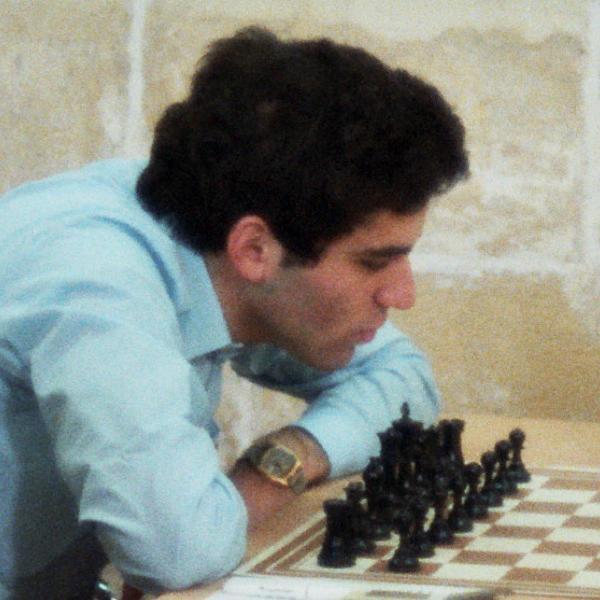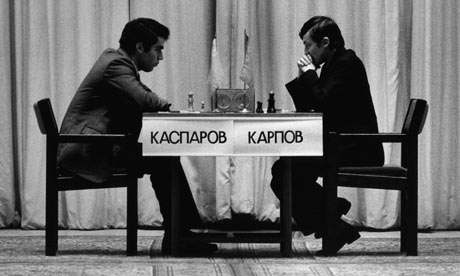
Karpov vs Kasparov: King's Indian Defense
Garry Kasparov, the 13th world champion, is closely connected to the King's Indian Defense. Indeed, he has created much of the foundation of what the opening is today.
Yet, early on in his epic rivalry with Anatoly Karpov, Kasparov restricted himself to the Queen's Gambit Declined to combat 1.d4. He started to use the Gruenfeld by the third match, but it was not really until after the fourth match that he began to essay the King's Indian against Karpov. Perhaps the confidence he had from the previous successful matches allowed this risky step.
Although they only played 15 games in the King's Indian out of their hundreds of total encounters, these were quite fascinating games that exposed some new concepts in this defense. So here we will look at some highlights.
First there were a couple of games where Karpov responded with the classical variation with 9.Nd2. The 1989 World Cup in Skelleftea featured this line. Kasparov got the better of it with a thematic sacrifice, destroying the blocked kingside. However, he missed his chances and Karpov held the draw.

In the first game of their 1990 match, Kasparov again used the King's Indian. This time Karpov responded with the Saemisch variation, 5.f3. Kasparov used the system with ...a6 and ...c6 -- known as the Byrne system -- in response. A key thematic moment was reached:
Karpov now captured 13.cxb5. Some players might automatically recapture 13...axb5, on the principle of capturing towards the center, keeping the pawn mass united, avoiding an isolated d-pawn, and so on. However, Kasparov played 13...cxb5!, which is an important theme for the King's Indian player to know.
Although Black's pawn structure looks better after 13...axb5, in fact it is rather unpleasant. The b- and c-pawns are inflexible, with neither one able to advance. White can thus put pressure on the open c- and d-files. Meanwhile, the black bishop is blocked in on b7 and it is hard for him to advance ...d5, since again after exd5 cxd5 he will be left with weaknesses.
After 13...cxb5, on the other hand, Black has none of these problems, while the d6-pawn is not actually weak. Black is generally able to advance ...d5. A similar pawn structure can also come about from other openings, such as the Ruy Lopez. The game later ended in a draw.
In his next game as Black, Kasparov again used the King's Indian. This time Karpov returned to the Classical, meeting 6...e5 with 7.Be3, the Gligoric system.
Kasparov used the now-rare 7...Qe7!?, and to the logical 8.dxe5 responded with a radical exchange sacrifice, which had heretofore not been played (except perhaps as a blunder). Throughout many games in the King's Indian, Kasparov has shown a willingness to give up a rook for the dark-squared (or even light-squared) bishop; we will see this theme again in a bit.
In the fifth game of the match, Kasparov again used the King's Indian, indicating that this was his main opening for that match. In that game he easily equalized. But in the seventh, Karpov managed to win in a game which troubled Kasparov greatly. First he accepted a rather rigid central structure, which is generally considered questionable, falling under positional pressure. Later an outright blunder decided the game.
But a bit later Kasparov was back with a good response to the Gligoric system. Yet another exchange sacrifice for the dark-squared bishop emerged, similar to the third game of the match. But this sacrifice was without a doubt sound, although it had never been played before, and as a result it changed opening theory.
After the moves 1.d4 Nf6 2.c4 g6 3.Nc3 Bg7 4.e4 d6 5.Nf3 0–0 6.Be2 e5 7.Be3 exd4 8.Nxd4 Re8 9.f3 c6 10.Qd2 d5 11.exd5 cxd5 12.0–0 Nc6 13.c5 the following position was reached:
Previously Black had played a variety of moves such as 13...Bd7 or 13...Qe7. But nobody thought of simply capturing the bishop -- which was hardly an obvious move. But Kasparov showed that Black's solid position and control over the dark squares would give him at least enough for the exchange:
Since this game, White has abandoned 10.Qd2, playing instead the less natural 10.Bf2, just to avoid this sacrifice.
Toward the end of the match, Kasparov again played the King's Indian, and this time Karpov returned to the Saemisch. The game was an epic battle, with Kasparov saving the draw by tremendously resourceful defense in a study-like ending:
In the penultimate game of the match, Kasparov again used the King's Indian. However, in this game he played rather weakly and Karpov won in thematic fashion. Kasparov had already clinched at least a tie (and the retention of his title) in the previous game, so probably he relaxed a bit.
The last of the great K-K matches was finished, but the rivalry continued in tournament games. In the following year in Tilburg, Kasparov introduced an incredible sacrifice in a known (and very chaotic) position:
The world champion played 19...Nxg3!?!, sacrificing a piece for only one pawn. After 20.hxg3 Nh5 the other knight was able to go to h5 and a path was opened for the queen. Now if White defended by 21.Kg2 a second knight would be sacrificed: 21...Nxg3! 22.Kxg3 f4+, followed by the entrance of the queen and the light-squared bishop.
Instead White played 21.f4, and after many vicissitudes another fantastic ending resulted, with three minor pieces fighting against a rook.
In the 1993 Linares tournament, the two champions played their final battle in the King's Indian. In this game, Kasparov managed to win in crushing fashion, where he managed to cause all of Karpov's pieces to retreat to their first rank!
All in all, the two world champions played 15 games with Kasparov as Black in the King's Indian. The result was two wins for Karpov, one for Kasparov, and 12 draws! It seems like a dreary outcome. But keep in mind that the incredibly high level of their play meant that in any case a huge number of their games were drawn; meanwhile, with Kasparov playing Black in every game, the minus-one score was not a bad result for him.
Despite the many draws, the games were full of great content, deeply enriching the King's Indian Defense with new ideas.






